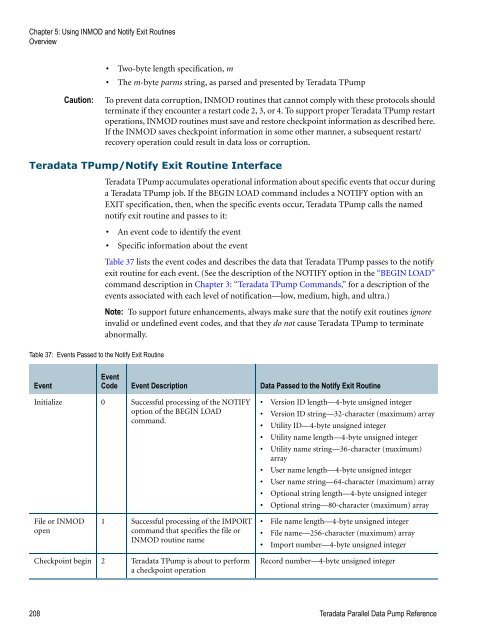Teradata Parallel Data Pump
Teradata Parallel Data Pump Reference - Teradata Developer ...
Teradata Parallel Data Pump Reference - Teradata Developer ...
- No tags were found...
You also want an ePaper? Increase the reach of your titles
YUMPU automatically turns print PDFs into web optimized ePapers that Google loves.
Chapter 5: Using INMOD and Notify Exit Routines<br />
Overview<br />
• Two-byte length specification, m<br />
• The m-byte parms string, as parsed and presented by <strong>Teradata</strong> T<strong>Pump</strong><br />
Caution:<br />
To prevent data corruption, INMOD routines that cannot comply with these protocols should<br />
terminate if they encounter a restart code 2, 3, or 4. To support proper <strong>Teradata</strong> T<strong>Pump</strong> restart<br />
operations, INMOD routines must save and restore checkpoint information as described here.<br />
If the INMOD saves checkpoint information in some other manner, a subsequent restart/<br />
recovery operation could result in data loss or corruption.<br />
<strong>Teradata</strong> T<strong>Pump</strong>/Notify Exit Routine Interface<br />
<strong>Teradata</strong> T<strong>Pump</strong> accumulates operational information about specific events that occur during<br />
a <strong>Teradata</strong> T<strong>Pump</strong> job. If the BEGIN LOAD command includes a NOTIFY option with an<br />
EXIT specification, then, when the specific events occur, <strong>Teradata</strong> T<strong>Pump</strong> calls the named<br />
notify exit routine and passes to it:<br />
• An event code to identify the event<br />
• Specific information about the event<br />
Table 37 lists the event codes and describes the data that <strong>Teradata</strong> T<strong>Pump</strong> passes to the notify<br />
exit routine for each event. (See the description of the NOTIFY option in the “BEGIN LOAD”<br />
command description in Chapter 3: “<strong>Teradata</strong> T<strong>Pump</strong> Commands,” for a description of the<br />
events associated with each level of notification—low, medium, high, and ultra.)<br />
Note: To support future enhancements, always make sure that the notify exit routines ignore<br />
invalid or undefined event codes, and that they do not cause <strong>Teradata</strong> T<strong>Pump</strong> to terminate<br />
abnormally.<br />
Table 37: Events Passed to the Notify Exit Routine<br />
Event<br />
Event<br />
Code Event Description <strong>Data</strong> Passed to the Notify Exit Routine<br />
Initialize 0 Successful processing of the NOTIFY<br />
option of the BEGIN LOAD<br />
command.<br />
• Version ID length—4-byte unsigned integer<br />
• Version ID string—32-character (maximum) array<br />
• Utility ID—4-byte unsigned integer<br />
• Utility name length—4-byte unsigned integer<br />
• Utility name string—36-character (maximum)<br />
array<br />
• User name length—4-byte unsigned integer<br />
• User name string—64-character (maximum) array<br />
• Optional string length—4-byte unsigned integer<br />
• Optional string—80-character (maximum) array<br />
File or INMOD<br />
open<br />
1 Successful processing of the IMPORT<br />
command that specifies the file or<br />
INMOD routine name<br />
• File name length—4-byte unsigned integer<br />
• File name—256-character (maximum) array<br />
• Import number—4-byte unsigned integer<br />
Checkpoint begin 2 <strong>Teradata</strong> T<strong>Pump</strong> is about to perform<br />
a checkpoint operation<br />
Record number—4-byte unsigned integer<br />
208 <strong>Teradata</strong> <strong>Parallel</strong> <strong>Data</strong> <strong>Pump</strong> Reference









